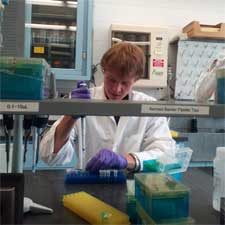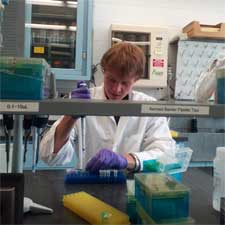 KINGSTON, R.I. – October 17, 2011 — University of Rhode Island biology major Matt Tinkham spent his summer studying tick-borne diseases. While he hopes to some day become a doctor, he now knows he wants to stay as far away from the blood-sucking creatures as possible.
KINGSTON, R.I. – October 17, 2011 — University of Rhode Island biology major Matt Tinkham spent his summer studying tick-borne diseases. While he hopes to some day become a doctor, he now knows he wants to stay as far away from the blood-sucking creatures as possible.
“I’d rather deal with people than bugs,” said Tinkham, a resident of Cranston.
However, he admits that the knowledge he acquired about tick-borne diseases, treatment, and prevention methods was enlightening. Treating people for these diseases is something he will no doubt experience in his medical career.
Tinkham wasn’t exactly thrilled with the idea of working with ticks at first, but Tom Mather, URI professor of entomology and Tinkham’s mentor, quickly spread his enthusiasm for the project.
The objective of the research was to see how many ticks on average are in Rhode Island compared to past years and find out where populations had increased or decreased. Tick samples were collected from throughout the state and tested for infectious diseases.
Young ticks, called nymphs, were most abundant in the leaf litter of forests in Charlestown, Jamestown, South Kingstown, Tiverton, Middletown and Newport, perhaps because the ticks prefer coastal locations with high humidity.
“If the humidity drops even for a couple days in the summer, a portion of the tick population dies,” Tinkham stated.
Tinkham’s research was undertaken as part of the URI Coastal Fellows program, a unique initiative designed to involve undergraduate students in addressing current environmental problems. Now in its 17th year, the program based in URI’s College of the Environment and Life Sciences teams students with faculty, research staff and graduate students to help them gain skills that will ensure their future success.
Getting used to working with these ticks while being aware of all of the diseases they carry was not an easy adjustment for Tinkham.
“The first day I was so paranoid,” he said.
Despite the long pants, high socks and boots that Tinkham wore each day, he still managed to get bitten by four deer ticks. After each session, Tinkham combed his body for any ticks that he may have overlooked and brought them to the lab to be tested for disease-causing microbes.
After adjusting to working with lab samples and overcoming his fear of ticks, Tinkham found these aspects of the project to be the most gratifying.
“The fact that I learned a lot about something I knew nothing about and was able to find it interesting and relevant was a reward in itself,” said Tinkham.
When in an area where ticks may be prevalent, Tinkham advises people to apply a tick repellent containing the chemical Permethrin to their clothing. The ticks generally won’t latch on but he stresses that it’s still a good idea for people to check their bodies thoroughly when returning home.

